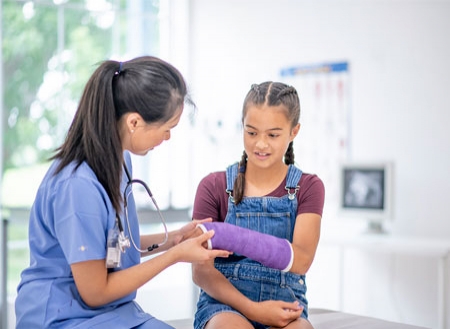Fractures are more common than most people would guess. People of all ages can and do sustain fractures that we see every day in our clinics. Fractures in and of themselves can have a varied timeline of treatment depending on a multitude of factors. However, a child’s anatomy and physiology in particular can make fracture treatment look remarkably different from the care provided to someone who is musculoskeletally mature.
When it comes to children, bones bend more than they break. This is due to the fact that the composition of the bone is not as porous and brittle as the more skeletally mature bones in adults. They are instead softer and more pliable. Have you watched a small child contort his or her body into a pretzel and wondered why it isn’t painful as you can only imagine the number of injuries you would sustain if you attempted the same feat? These types of fractures are called buckle fractures because the bone does just that-it buckles rather than breaking. They are still treated in the standard fashion to include a brief period of immobilization (typically in a cast) and then a progressive return to activity as tolerated.
Depending on the age of the child, his or her growth plates are likely to still be open to allow for continued growth and development of the bones. Fractures that involve a growth plate at the end of a bone can complicate the treatment. These fractures are given particularly close attention because if they heal inappropriately, the growth at that plate can be hindered. Fractures that include the growth plate are called Salter-Harris fractures and are classified using 5 different categories that correlate to the extent of growth plate involvement. These fractures are also most often treated with a cast, x-ray monitoring over time to assess healing, and progressive return to activity.
This concept of open growth plates and fractures affecting the overall growth of a bone is a little unsettling for parents of small children, but worry not! Open growth plates are also the reason that your child can sustain an angulated fracture and not need surgical intervention to fixate the bones and restore alignment. The younger the child and the more open the growth plate, the more angulated can be endured with adequate restoration of alignment of the involved bone over time. Children’s bodies are continuously laying down new bone as they grow anyway. The body will lay down new bone around the fracture site to mold the fracture back into an anatomical position.
Children are incredibly resilient little creatures, but these injuries should still be diagnosed and treated in a timely fashion to prevent long term complications. If your child has any kind of trauma and complains of pain or fails to use an extremity normally, they should be evaluated with x-rays sooner than later. If you notice swelling and bruising, that is usually a sign that some kind of pathology is present. Don’t forget, OAW has Ortho-ASAP hours at both our Pewaukeeand Brookfield locations for all of your fracture-related needs!
This blog is written by one of our very own-Morgan. She is a certified athletic trainer working in our clinic with our providers each and every day. She obtained a bachelor's degree in athletic training from Carroll University in Waukesha and a master's degree in Kinesiology from Michigan State University.

